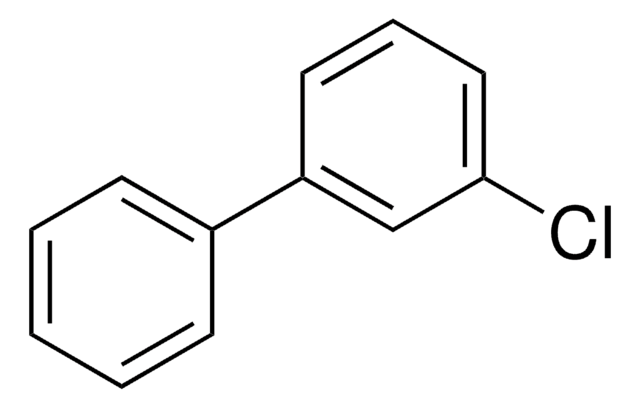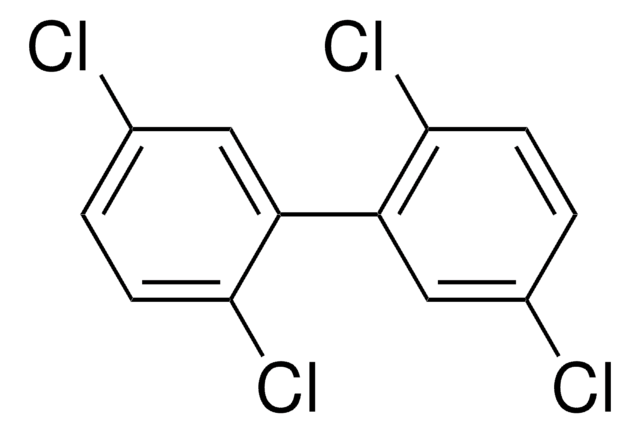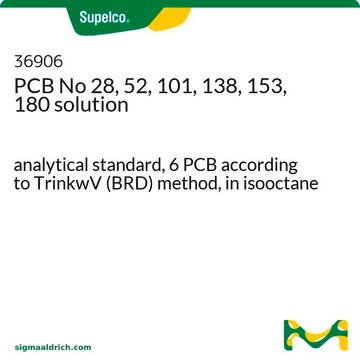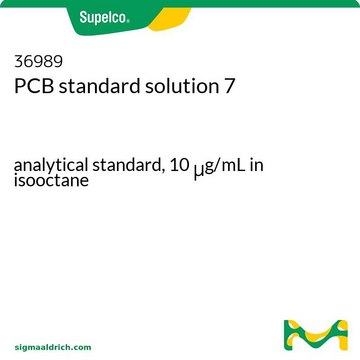推荐产品
一般說明
Polychlorinated biphenyls (PCBs) belong to the class of highly toxic pollutants commonly found in various environmental matrices and food products. They find a variety of applications as flame retardants, plasticizers, dielectric and heat transfer fluids, etc.
應用
PCB No 3 may be used as an analytical reference standard for the quantification of the analyte in aqueous solution in the presence of dissolved organic carbon using high-performance liquid chromatography technique.
Refer to the product′s Certificate of Analysis for more information on a suitable instrument technique. Contact Technical Service for further support.
推薦產品
Find a digital Reference Material for this product available on our online platform ChemisTwin® for NMR. You can use this digital equivalent on ChemisTwin® for your sample identity confirmation and compound quantification (with digital external standard). An NMR spectrum of this substance can be viewed and an online comparison against your sample can be performed with a few mouseclicks. Learn more here and start your free trial.
訊號詞
Warning
危險聲明
危險分類
Aquatic Acute 1 - Aquatic Chronic 1 - STOT RE 2
儲存類別代碼
11 - Combustible Solids
水污染物質分類(WGK)
WGK 3
閃點(°F)
Not applicable
閃點(°C)
Not applicable
個人防護裝備
dust mask type N95 (US), Eyeshields, Gloves
Anna Ptak et al.
Reproductive toxicology (Elmsford, N.Y.), 20(1), 57-64 (2005-04-06)
Theca interna and granulosa cells from small, medium and large preovulatory porcine follicles were cultured as a monolayer to compare the effects of 4-chlorobiphenyl (PCB3) and its metabolites on estradiol secretion. Cells were treated with PCB3 or its mono- and
Ariane Toussaint et al.
Applied and environmental microbiology, 69(8), 4837-4845 (2003-08-07)
The nucleotide sequence of the biphenyl catabolic transposon Tn4371 has been completed and analyzed. It confirmed that the element has a mosaic structure made of several building blocks. In addition to previously identified genes coding for a tyrosine recombinase related
J A Jacobus et al.
Environment international, 36(8), 970-979 (2010-08-27)
Polychlorinated biphenyls (PCBs) are a class of persistent organic pollutants with myriad biological effects, including carcinogenicity. We present data showing gender-specific genotoxicity in Fischer 344 transgenic BigBlue rodents exposed to 4-chlorobiphenyl (PCB3), a hydroxylated metabolite, and the positive control 3-methylcholanthrene
Anna Ptak et al.
Toxicology letters, 166(3), 200-211 (2006-09-05)
Polychlorinated biphenyl (PCBs) levels of tens and hundreds of pg/ml for individual congeners are measured in human follicular fluid. PCB3 (4-chlorobiphenyl), caused a significant increase in estradiol secretion in porcine granulose-theca cell co-cultures and its two metabolites, 4-OH-PCB3 and 3,4-diOH-PCB3
Kiran Dhakal et al.
Chemical research in toxicology, 25(12), 2796-2804 (2012-11-10)
Polychlorinated biphenyls (PCBs) are legacy pollutants that exert toxicities through various mechanisms. In recent years exposure to PCBs via inhalation has been recognized as a hazard. Those PCBs with lower numbers of chlorine atoms (LC-PCBs) are semivolatile and have been
我们的科学家团队拥有各种研究领域经验,包括生命科学、材料科学、化学合成、色谱、分析及许多其他领域.
联系技术服务部门










